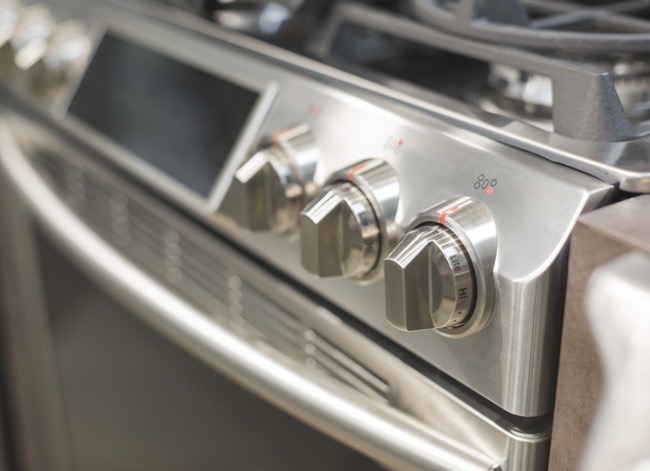

We may earn revenue from the products available on this page and participate in affiliate programs. Learn More ›
Q: As part of my kitchen remodel, I want stylish new appliances. Fingerprint-resistant stainless steel seems to be a great idea, but untreated stainless steel is still widely available. Are there any potential problems I should be aware of?
A: Stainless steel has long been a favorite for kitchen appliances because of its sleek appearance, but it does tend to show every fingerprint as an obvious mark, and many people find that frustrating. If roommates or families are in and out of the kitchen all the time (and particularly the fridge), keeping things clean can seem like a constant battle.
So, fingerprint-resistant stainless steel seems to be an ideal solution, but before we make that recommendation let’s take a look at the facts.
Related: How to Remove Scratches From Stainless Steel
Fingerprint-resistant stainless steel features a durable coating.
Fingerprint-resistant wipes and polishes for use on existing stainless steel appliances have been available for some time. These smudge-proof coatings can successfully reduce how often appliances need cleaning, but the products still need fairly regular use. It very much depends on “traffic,” but if kids and adults come into contact with the appliances often, it can remain a weekly chore.
By contrast, the factory method now used by many appliance manufacturers sprays the panels with a permanent clear coating. It is much like the final clear topcoat that protects vehicle paintwork and dries very hard. The mechanized process produces a flawless finish. It offers much improved durability and helps shed the oil and grease that are inherent in fingerprints, so the marks don’t show.

Today, most major appliance manufacturers offer fingerprint-resistant options.
Often called “smudge-proof” finishes, the surfaces on many newer stainless steel appliances feature a fingerprint-resistant coating. These refrigerators, ovens, and dishwashers have the same sleek look of steel, but a matte or brushed appearance.
The heavy brushing can lead to a slightly darker look, and might not match other stainless appliances in your kitchen. The brushed surface might be available in stainless steel, black stainless steel, and other metal finishes.
Related: The Pros and Cons of Black Stainless Steel
It can be difficult to match fingerprint-resistant finishes to your existing stainless steel appliances.
There can be issues matching new items to existing appliances that don’t feature the same fingerprint-resistant treatment. Buying all new appliances should solve the problem if they are from the same manufacturer, but there’s no guarantee of a consistent look if you mix brands.
There are a couple of reasons for this. One is that there are numerous different grades of stainless steel; depending on the manufacturing process, each can be a slightly different color. Another is that stainless steel is seldom polished but usually keeps the brushed grain effect. Differences in how this is applied impact how the panel reflects light.
Panels that are not fingerprint-resistant need to be of good quality stainless steel to maintain their appearance. Generally, these have high levels of chromium and nickel. It makes the metal harder and the finish brighter. The nickel also makes them nonmagnetic. This long-lasting toughness and brightness in the metal is not so important when a protective finish is used, so panels might come in a lower grade stainless steel. Basic stainless steels often are magnetic.
This is unlikely to have an impact on the overall durability of the appliance, but frequently makes a difference in color. That said, it is up to the individual to decide whether the difference is enough to be a problem. Often, it can be hard to tell unless the appliances sit right alongside each other.

Cleaning fingerprint-resistant stainless steel is simple.
The protective skin applied to stainless steel to make it fingerprint-resistant is very easy to clean. In general, appliance manufacturers say that unlike ordinary stainless steel, the brushed surfaces need no special cleaning products. A wipe with a microfiber cloth will often be all that’s needed. You also can use a solution of water and mild dish soap.
However, several manufacturers point out that if you wet the surface, be sure to also dry it using a soft cloth. Wipe in the direction of the “grain” of the brushed finish. If this is not done, a bluish discoloration is possible, particularly with ovens when they warm up.
The fingerprint-resistant layer is tough, but not indestructible. It is vital to avoid using any kind of harsh chemicals to clean it. Avoid using bleaches, vinegars, metal cleaners, scourers and abrasive cloths. They can soften, scratch or cut through the coating. This will leave dull patches and could eventually damage the stainless steel beneath.
Related: 8 Mistakes That are Marring Your Stainless Steel Appliances
Fingerprint-resistant options might be more expensive.
Some appliance manufacturers now add fingerprint-resistant coatings to all their products. Others might offer the option of one or the other. It is not unusual for fingerprint-resistant stainless steel appliances to cost a little more than traditional stainless ones. That said, it is a highly competitive market, so if you are not set on a particular brand it is worth shopping around.
The benefits of a fingerprint-resistant stainless steel appliance are obvious. The finish is not only easier to keep clean, it is a tough protective layer on top of the stainless steel, so it is likely to stay looking great for longer. If prices are competitive, there seem to be no real drawbacks.

